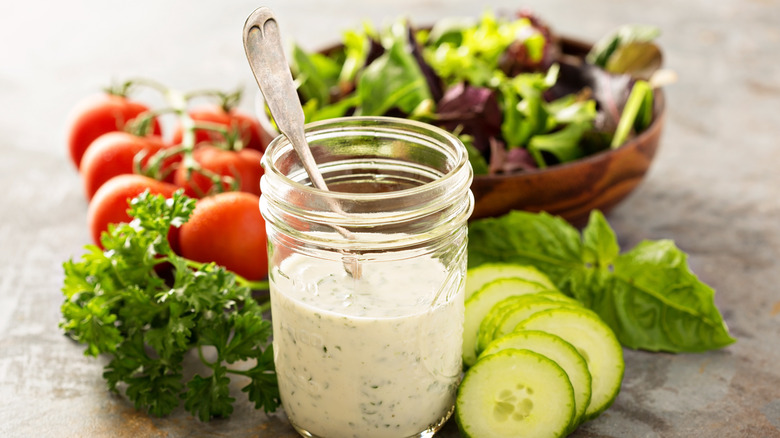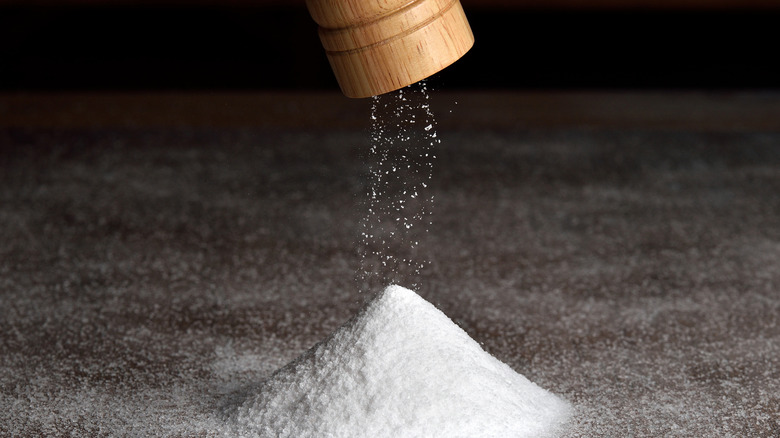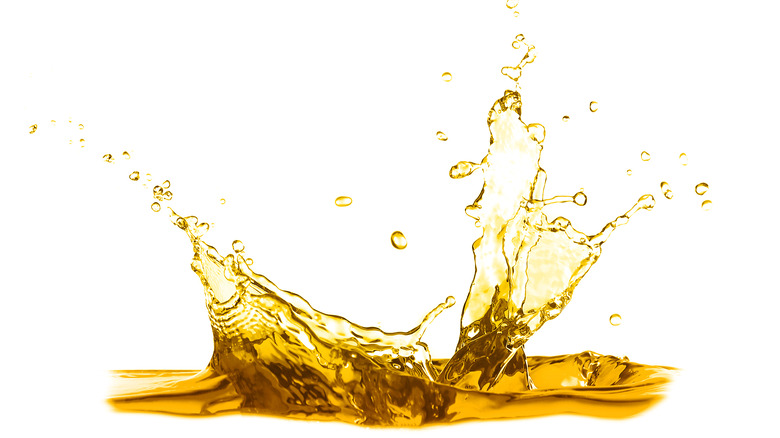How Unhealthy Is Ranch Dressing?
Is ranch dressing your favorite condiment? Do you put it on everything, or just add it to your salad? If you're eating a lot of it, you might be negatively impacting your health. How negative that impact is depends on how much you eat and which brand you buy. A search in the USDA FoodData Central database brings back nearly 1,000 different brands of ranch dressing. Let's look at the nutritional value of two of the most readily available brands — Hidden Valley and Kraft.
One serving of Hidden Valley Ranch — two tablespoons — has 130 calories, 14 grams of total fat, two grams of saturated fat, five milligrams of cholesterol, 260 milligrams of sodium, two grams of carbs, and one gram of total sugar (via Hidden Valley).
One serving of Kraft Ranch Dressing — two tablespoons — has 110 calories, 11 grams of total fat, 1.5 grams of saturated fat, 10 milligrams of cholesterol, 260 milligrams of sodium, two grams of carbs, and one gram of total sugar (via Kraft Heinz).
You can see from the nutritional content that both are high in calories, fat, and sodium. And unfortunately, the main ingredients in ranch dressing are typically vegetable oil, soybean and/or canola, buttermilk, sugar, egg yolks, salt, and water. Then, there are some spices added like garlic, onion, dill, preservatives, and natural and artificial flavors, but what does all this mean for your health?
Ranch is high in sodium
Your daily intake of sodium should be limited to 2,300 milligrams or less per day, which is what one teaspoon of salt has. And if you are at risk for high blood pressure or heart disease, your sodium intake needs to be less than 1,500 milligrams a day (via the Mayo Clinic and the American Heart Association). That means, four servings of ranch dressing brings you to your limit.
Too much sodium can be detrimental to your health, leading to high blood pressure, heart disease, and stroke. While salt is necessary for your health, you only need about 500 milligrams a day. That's less than two servings of the typical ranch dressing, which contains 520 milligrams of sodium. If you have to have your ranch dressing, go with a low sodium option or make it yourself so you can control how much salt is in it (Harvard Health Publishing).
Ranch is high in saturated fat, too
In addition to the sodium concerns, the saturated fat in ranch dressing (which comes from the vegetable oil) is also concerning. While fat is necessary for a balanced diet, saturated fat can increase your bad cholesterol and your risk of heart disease. A healthy rule of thumb? Try to limit your intake of saturated fat to about 5% of your daily calorie intake. If you have 2,000 calories a day, that brings your limit to 13 grams of saturated fat per day, according to the American Heart Association.
With 1.5 to two grams of saturated fat per serving of ranch dressing, that can add up fast with your other food and drink choices throughout the day. The total fat in one serving of ranch dressing is up to 14 grams, depending on the brand you buy. Fat gives you energy, and is good for your brain, hormone regulations, vitamin absorption, and helps you feel fuller longer (via Healthline), but just make sure you're fueling up with the right kind of healthy fats.
It would be ideal to completely eliminate ranch dressing and other processed foods from your diet, but if you have to have it, there are some tricks you can use. Opt for low sodium ranch dressing made with yogurt or make your own. And when you do have it, measure out your serving size instead of guessing what two tablespoons is. You might be surprised at how much you've been eating. How unhealthy ranch dressing depends on your health, risk factors, and how much of it you eat.



